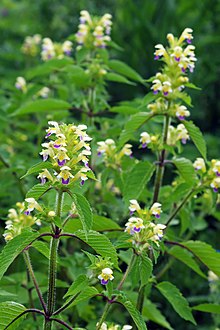
Chaenomeles is a genus of four species of deciduous spiny shrubs, usually 1–3 m tall, in the family Rosaceae. They are native to Southeast Asia. These plants are related to the quince and the Chinese quince, differing in the serrated leaves that lack fuzz, and in the flowers, borne in clusters, having deciduous sepals and styles that are connate at the base.
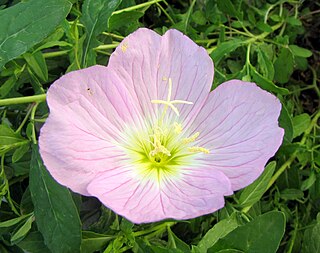
Oenothera speciosa is a species in the Oenothera family known by several common names, including pinkladies, pink evening primrose, showy evening primrose, Mexican primrose, amapola, and buttercups.
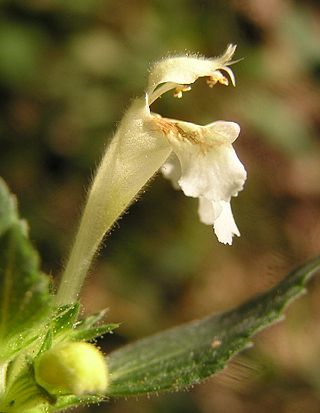
Galeopsis segetum, commonly known as downy hemp-nettle, is a species of flowering plant in the sage family, Lamiaceae. It grows as a weed in arable ground throughout Europe. Although superficially resembling the stinging nettle it is of a different family and does not sting.
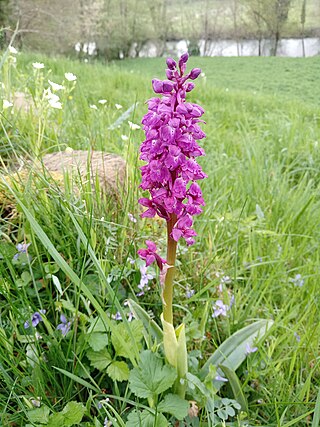
Orchis mascula, the early-purple orchid, early spring orchis, is a species of flowering plant in the orchid family, Orchidaceae.

Galeopsis tetrahit, the common hemp-nettle or brittlestem hempnettle, is a flowering plant in the family Lamiaceae, native to Europe and northwestern Asia.

Chaenomeles speciosa, the flowering quince, Chinese quince, or Japanese quince, is a thorny deciduous or semi-evergreen shrub native to eastern Asia. It is taller than another commonly cultivated species, C. japonica, usually growing to about 2 m. The flowers are usually red, but may be white or pink. The fruit is a fragrant but hard pome that resembles a quince.

Gambelia speciosa, previously classified as Galvezia speciosa, is commonly known as showy island snapdragon or showy greenbright.
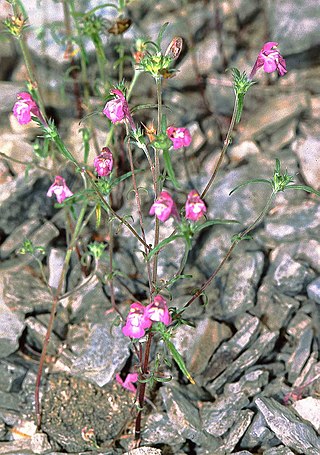
Galeopsis ladanum var. angustifolia, the red hemp-nettle, is a European annual plant growing to 30 cm tall. It flowers between June and October on waste ground, railway tracks, and other stony places. It is classified as critically endangered, having declined dramatically in the last 60 years due to increased fertiliser and herbicide. Modern farming techniques such as autumn cultivation have also affected the plant because they are killed before they have set seed.

Streblorrhiza was a monotypic genus of legumes in the family Fabaceae. Its only species was Streblorrhiza speciosa, a perennial shrub endemic to Phillip Island. It is now presumed extinct.

Perizoma alchemillata, the small rivulet, is a moth of the genus Perizoma in the family Geometridae. The species was first described by Carl Linnaeus in his 1758 10th edition of Systema Naturae.

John Isaac Briquet was a Swiss botanist, director of the Conservatoire Botanique at Geneva.

Vandenboschia speciosa, synonym Trichomanes speciosum, commonly known as the Killarney fern, is a species of fern found widely in Western Europe. It is most abundant in Ireland, the United Kingdom, Brittany, Galicia, Canary Islands, Madeira and the Azores, but is also found in other locations including France, Spain, Portugal and Italy. It is a relict endemic European species with a disjunct distribution, having had a much wider distribution before the climate changes of the Tertiary and Quaternary periods.

Solidago speciosa, the showy goldenrod, is a North American species of flowering plants in the family Asteraceae. It grows in the province of Ontario in central Canada, as well as in the eastern and central United States.

Galeopsis, commonly called hemp-nettle or hempnettle, is a genus of annual herbaceous plants native to Europe and Asia. Some species are naturalized in North America and New Zealand.

Cassida viridis, common name green tortoise beetle, is a species of beetle in the leaf beetle family (Chrysomelidae).

Aloe speciosa is a species of flowering plant in the Asphodelaceae family. It is commonly called tilt-head aloe and is an arborescent aloe indigenous to the thicket vegetation of the southern Cape Provinces of South Africa.

Liriomyza eupatorii is a species of fly in the family Agromyzidae. The fly, is found in Europe and was described by the German entomolgist, Johann Heinrich Kaltenbach in 1874.
Galeopsis ladanum is a species of flowering plant belonging to the family Lamiaceae.
Hoverdenia is a monotypic genus of flowering plants belonging to the family Acanthaceae. It only contains one species, Hoverdenia speciosa.

Galeopsis pubescens, also known as the hairy and downy hempnettle, is a herbaceous annual plant species in the family Lamiaceae, that can be found growing in various European countries.
